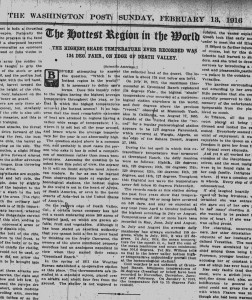While we’re feeling the heat as truly summer-like temperatures in the 90s are making themselves known, the risk of wildfire increases throughout the country.
At the time this was written, 24 wildfires were burning throughout the country. Maps put out by the National Interagency Fire Center (like this one) show the location of “large incidents,” or large uncontrollable fires that were currently burning at the time of map-making. Other maps (like this one) can help you determine the likelihood of a wildfire starting in your area.
As a wise bear has said, we all have the power to prevent wildfires and forest fires. Here at Special Collections, anyone looking through our poster collection will find several 1940s-era posters reminding us of this fact.

Smokey Bear, the bear who has such confidence in us humans to prevent forest fires, is the longest running PSA campaign in United States history. In 1950, a bear cub was orphaned by a forest fire in New Mexico. Rangers rescued him from the fire and nursed him back to health until he eventually left for a zoo in Washington, D.C. where he became the living symbol for the Smokey Bear fire prevention campaign that is still popular today.
 As the poster to the left suggests, the importance of preventing wildfires was felt very strongly in the forties, due to the war-effort. In fact, the first half of that decade was when this awareness/prevention campaign really started to spread like wildfire (pun intended). Large, uncontained fires would take attention and supplies away from the troops that were in need of them, making forest fires not only a danger to those near them, but also to those overseas. Luckily for all of us, there are several easy steps to take to prevent uncontained fires conveniently recorded on this poster, such as making sure your campfire has been put out thoroughly before breaking camp.
As the poster to the left suggests, the importance of preventing wildfires was felt very strongly in the forties, due to the war-effort. In fact, the first half of that decade was when this awareness/prevention campaign really started to spread like wildfire (pun intended). Large, uncontained fires would take attention and supplies away from the troops that were in need of them, making forest fires not only a danger to those near them, but also to those overseas. Luckily for all of us, there are several easy steps to take to prevent uncontained fires conveniently recorded on this poster, such as making sure your campfire has been put out thoroughly before breaking camp.
In addition to putting forth practical reasons for being careful with fire, the forestry service around this time also tugged at the heartstrings of Americans by issuing posters with Bambi and friends, imploring those that look upon them to not burn down their homes. As the Disney movie had just debuted the previous year, this poster would have been particularly effective in its message of reminding people of the devastating effects fires have on forest wildlife.
So remember:
- “only you can prevent wildfires”
- to see these posters (and others) all you need to do is visit us at Special Collections!

